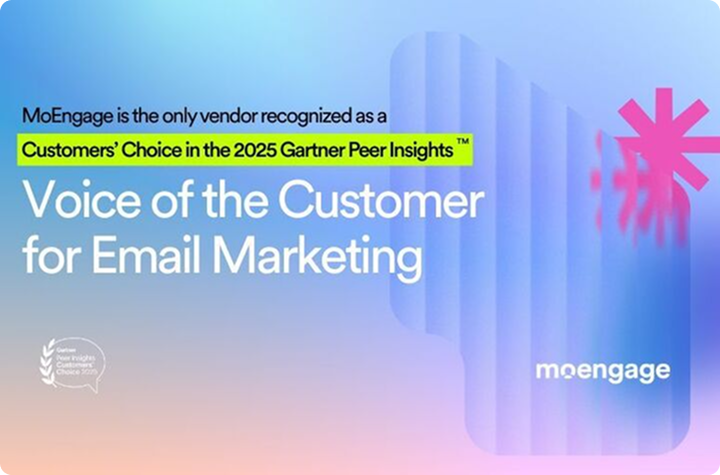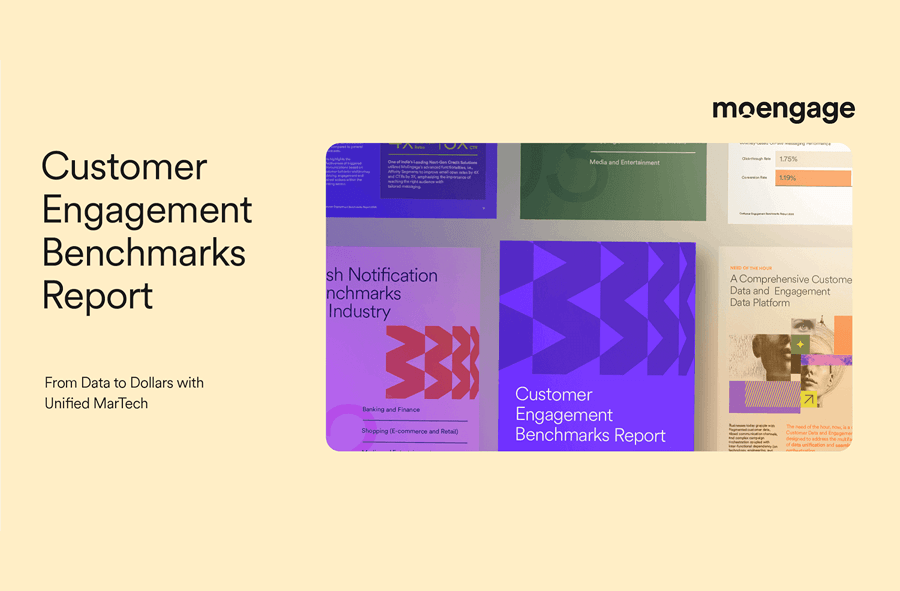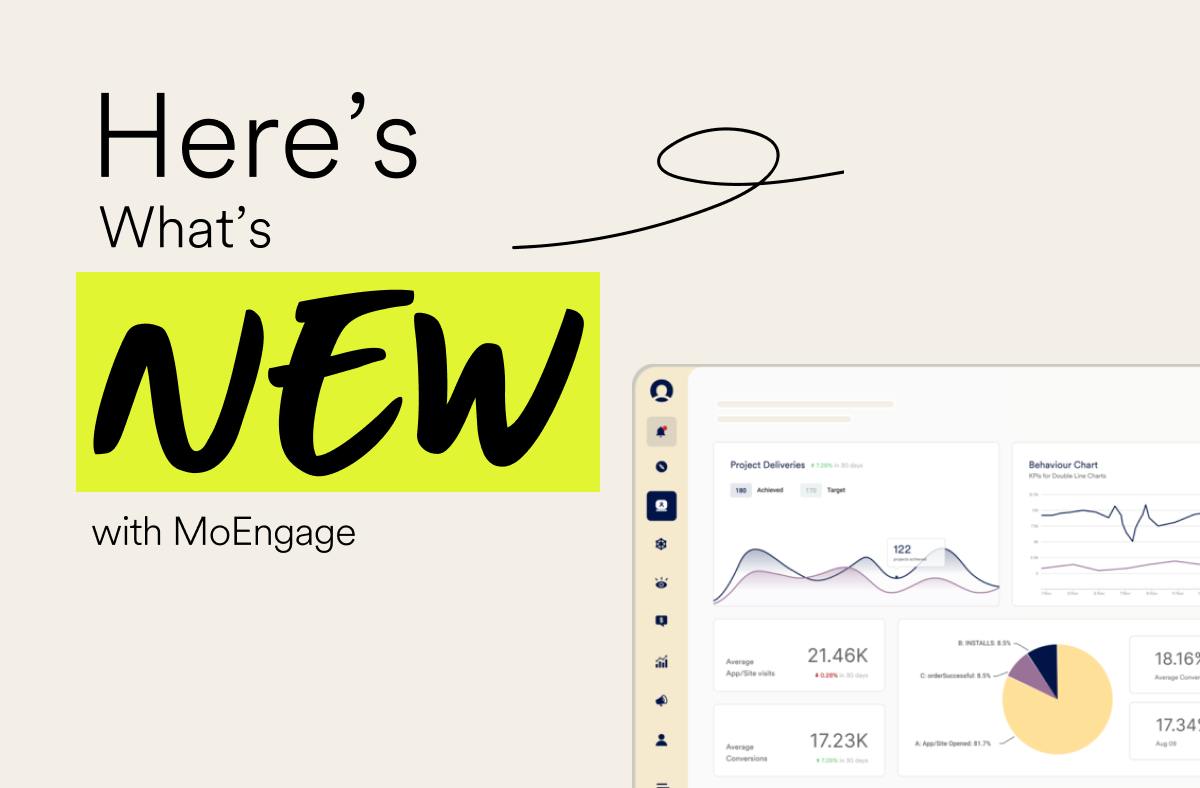The Only Email Compliance Guide You’ll Ever Need
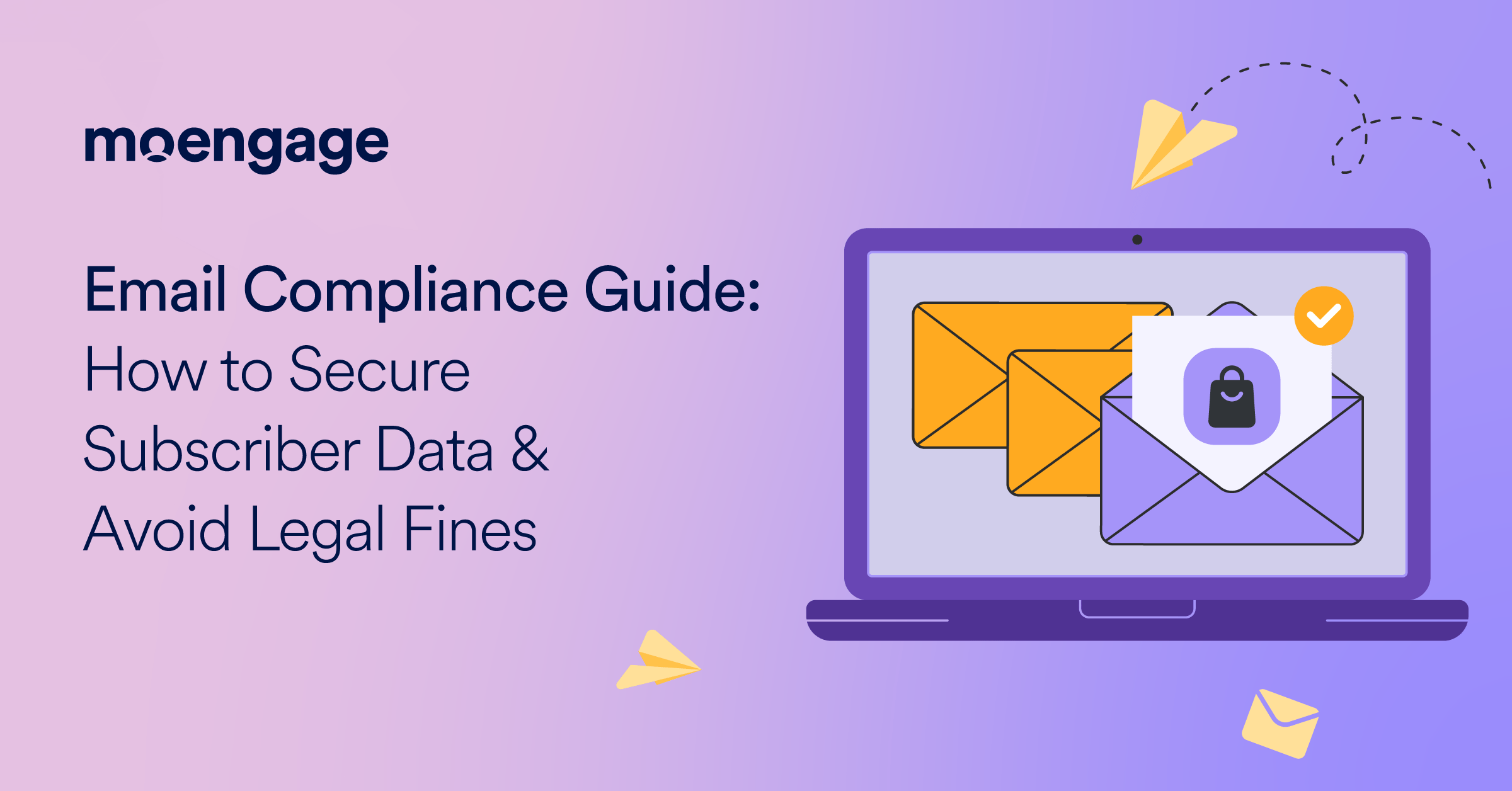
Reading Time: 15 minutes
Remember the $650,000 penalty that Experian Consumer Services faced for email violations in 2023? Yeah, ouch. The moral of the story? Email compliance is a legal, financial, and brand-saving necessity.
When you hit “send” on an automated email marketing campaign, are you sure you’re following the rules? If you’re not, you’re playing with fire. Whether you’re sending a friendly newsletter or customer onboarding instructions, failing to meet email compliance regulations could damage your reputation, land you in legal trouble, or even get your emails flagged as spam.
But there’s no need to panic, folks! This guide will untangle email compliance once and for all, cutting through the jargon (like SPF, DKIM, and GDPR) so you can focus on what actually matters: delivering value to your audience.
Let’s dive in.
What is Email Compliance in Marketing?
Email marketing compliance is the process of ensuring all marketing emails adhere to privacy laws, industry standards, and regulations, such as the Controlling the Assault of Non-Solicited Pornography and Marketing Act of 2003 (CAN-SPAM Act) in the US and the General Data Protection Regulation (GDPR) in the EU. It ensures that your email marketing campaigns respect customer privacy, promote transparency, and avoid deceptive practices, allowing your brand to build credibility.
Email compliance doesn’t just revolve around local rules. You’re expected to follow regulations wherever your recipients live. For example, you might be a US-based marketer, but with all those subscribers from London? Yeah, you need to abide by GDPR.
When your recipients can trust you to respect their choices (opt-ins, preferences, and unsubscriptions), your emails are far more likely to land in inboxes and stay there.
Why is email compliance important in marketing?
Email inboxes are sacred ground. Customers don’t hand over their email addresses so they can be spammed relentlessly or misled by shady marketing tactics. Email compliance laws like GDPR and CAN-SPAM exist for exactly that reason. Compliance is how you earn trust, avoid penalties, and grow an engaged audience.
When email campaigns play with compliance, domains get flagged. Internet Service Providers (ISPs) start questioning your sender reputation, spam complaints skyrocket, and suddenly, even your most loyal subscribers stop seeing your emails altogether. It’s digital banishment, plain and simple.
But it’s not all doom and gloom. Nail email compliance, and it becomes one of your greatest assets. Beyond email deliverability, complying with regulations helps you build a positive brand reputation. When subscribers know their privacy is respected and they have control over their email preferences, they are more likely to engage with your content and remain loyal customers.
It’s a win-win: you avoid legal headaches and cultivate a more engaged, trusting audience.
What are the consequences of not following email compliance regulations?
Let’s just rip off the Band-Aid: non-compliance is expensive. “How expensive?” you ask. Well, let’s break it down.
In the US, the maximum penalty for unintentionally violating the California Consumer Privacy Act (CCPA) is $2,663 per breach. For violating it intentionally, brands may face penalties of up to $7,988 per breach.
And under the CAN-SPAM Act, fines can reach up to $53,088 per separate offending email. Repeat offenders can quickly rack up millions, especially when dealing with bulk campaigns.
Want an example? In 2024, security camera vendor Verkada faced $2.95 million in CAN-SPAM penalties for—wait for it—sending a barrage of marketing emails without the option to unsubscribe or opt out.
Globally, GDPR doesn’t play nice either. This regulation takes things up a notch with fines reaching up to €20 million or 4% of a company’s total revenue the previous year, whichever is higher (yes, you read that right). Amazon’s €746 million ($812 million) fine for breaking GDPR’s rules was a mic drop.
Beyond fines, the consequences include damaged reputation, decreased deliverability rates, and possibly even lawsuits from recipients who feel their data or consent rights were violated. Oh, and good luck explaining all that to your C-suite team while you scramble to fix it.
In short, ignoring email compliance regulations is a reckless move. Financial penalties aside, the trust your customers lose is even harder to recover once your name is dragged through the mud for privacy violations.
8 Email Compliance Requirements to Follow
Email marketing compliance isn’t exactly one-size-fits-all. Depending on where you operate (and where your recipients live), different jurisdictions have different rules. Toss in industry-specific email compliance regulations like the Health Insurance Portability and Accountability Act of 1996 (HIPAA) or those set by the Financial Industry Regulatory Authority (FINRA), and your email compliance checklist starts looking more like a novel.
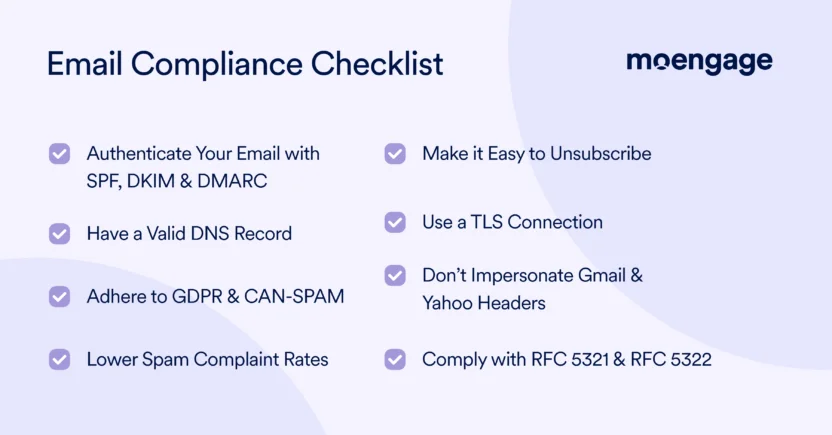
Here are eight must-follow requirements to help your email marketing campaigns stay both effective and lawful:
1. Authenticate Your Email with SPF, DKIM, and DMARC
Sender Policy Framework (SPF), DomainKeys Identified Mail (DKIM), and Domain-based Message Authentication, Reporting, and Conformance (DMARC) are like the Holy Trinity of email authentication. They’re technical protocols that prevent scammers from impersonating your domain and using it to spam or phish your audience.
The thing is, email providers like Gmail and Outlook aren’t playing around when it comes to identifying sender legitimacy. If your emails aren’t properly authenticated, they might never even make it to the inbox.
To fix this, get access to your domain’s DNS settings. You’ll need to configure SPF to list all the servers allowed to send emails on your behalf, DKIM to digitally “sign” your emails to prove they came from you, and DMARC to lay down the anti-spoofing law. Most email platforms, like Google Workspace or your ESP (email service provider), have guides for this. Yes, it’s technical, but it’s also table stakes.
Work with your IT team or email service provider (ESP), or hire help if necessary, because without these protocols, your email compliance is just a house built on sand. Regularly monitor your DMARC reports to identify any authentication failures or potential spoofing attempts.
2. Have a Valid DNS Record
A DNS (Domain Name System) record is essentially the Internet’s phonebook. For email, specifically, it translates your domain name (e.g., yourcompany.com) into an IP address that email servers can understand. A valid DNS record is fundamental for email deliverability because it proves that your domain exists and is authorized to send emails. Without it, email servers can’t verify your sender identity, leading to emails being rejected or marked as spam.
Marketers often mistakenly assume that having a functioning domain automatically guarantees proper DNS configuration. Spoiler alert: it doesn’t. You need to actively check this.
Coordinate with your IT team (or whoever manages your domain hosting) to ensure that your DNS is set up correctly. Tools like MXToolbox can quickly check your DNS health, identify potential issues, and confirm that you’re sending emails from a verified source.
3. Adhere to GDPR and CAN-SPAM
At their core, GDPR and CAN-SPAM exist to protect customers from email overload and shady practices. GDPR focuses on EU residents and emphasizes explicit, informed consent before sending marketing emails. Meanwhile, CAN-SPAM applies to the US and sets requirements for clear sender identities, truthful subject lines, and providing an easy way to opt out.
What this means for you: Stop buying and start building email lists organically. Ensure all your subscribers have willingly opted in to receive emails, preferably through a double opt-in process. That’s where customers confirm their subscription by clicking a link in a confirmation email. It’s an extra step, but customers who opt in twice are far less likely to complain, or worse, report you.
Additionally, always include clear sender fields (your brand name works nicely), accurate subject lines, and a functional unsubscribe link. Not doing so isn’t just poor etiquette, it’s against the law and can lead to those hefty fines you’ve heard nightmares about.
4. Lower Spam Complaint Rates
When recipients mark your emails as spam, it’s not just bad for your ego — it’s bad for your reputation, too. Spam complaints signal to email service providers (ESPs) that your emails may not be trustworthy. A spam complaint rate above 0.1%, and your domain’s reputation will tank faster than a lead balloon.
First, let’s address this head-on by sending emails only to recipients who actually want them. Ensure you’re honoring opt-outs and keeping your contact lists updated; emailing someone who stopped engaging with you three years ago is a fast track to the spam folder.
Also, give recipients what they expect. If they subscribed for educational content, don’t send a hard sales pitch. Misaligned content can make an email feel spammy, even if it’s technically compliant.
5. Make it Easy to Unsubscribe
Here’s an uncomfortable truth: not everyone who subscribes to your list is going to stay forever. And that’s okay. What’s not okay is making it difficult or frustrating for customers to opt out. In fact, GDPR, CAN-SPAM, and almost every major email compliance regulation mandates an easy-to-find unsubscribe link in every email.
Basically, it’s about respecting the relationship you’ve built with your audience. If someone unsubscribes on good terms, they’re more likely to engage with your brand in other ways later. Include an obvious “unsubscribe” link in the footer of every email, and don’t bury it in tiny eight-point font. You’re not fooling your customers, nuh-uh.
6. Use a TLS Connection for Transmitting Emails
TLS (Transport Layer Security) is an encryption protocol that secures communications over a network, including email transmission. When emails are sent via a TLS connection, the content is encrypted, preventing unauthorized parties from intercepting and reading your messages.
This is crucial for protecting sensitive data, maintaining privacy, and enhancing the security of your email communications, which is a growing expectation from ISPs and recipients alike.
Most reputable email service providers offer TLS encryption as a default setting, but you’ll want to confirm that it’s enabled for both outgoing and incoming emails. If you manage your own mail server, configure it to enforce TLS.
7. Don’t Impersonate Gmail and Yahoo Headers
Impersonating email headers of major email providers like Gmail or Yahoo involves forging the “From” address to make it appear as if an email originated from one of their domains (e.g., using [email protected] as your sender address when you’re not Google). It’s not only deceptive, but it’s also a red flag to spam filters, who will happily blacklist you for this stunt.
Instead, focus on establishing trust by using your own verified email domain and ensuring your IP reputation is spotless. Never attempt to spoof or imitate well-known email providers, and let proper authentication (SPF, DKIM, and DMARC again) do the heavy lifting.
8. Comply with RFC 5321 and RFC 5322
These may sound like robot names from a sci-fi film, but hear us out.
RFC 5321 (Simple Mail Transfer Protocol or SMTP) and RFC 5322 (Internet Message Format or IMF) are technical standards that define how email messages are structured and transmitted. RFC 5321 specifies the protocol for sending emails between servers, while RFC 5322 details the format of the email message itself (headers, body, etc.).
Email compliance with these RFCs ensures that your emails are technically well-formed and can be correctly processed by mail servers worldwide.
The simplest way to comply with these standards is to use a trusted email service provider. Reputable platforms already have these RFC frameworks baked into their infrastructure, so you don’t have to sweat the tiny details. Still, it doesn’t hurt to have a checklist in place to test for formatting issues before hitting send.
How to Check if Your Marketing Emails are Compliant
When was the last time you double-checked if your marketing and customer relationship emails were actually compliant? Don’t worry, no judgment.
Most marketers assume that so long as their emails are getting delivered, they’re in the clear. Spoiler alert: that assumption can cost you.
Okay, so how do you know if you’re on the right track? Here are five steps that will let you sleep easily, knowing your emails check all the boxes.
- Get and manage subscriber consent: Verify that all your subscribers have explicitly opted in to receive your emails. Implement double opt-in processes where possible.
- Implement secure email signatures: Ensure your SPF, DKIM, and DMARC records are correctly configured and actively monitored. This proves your email’s authenticity.
- Include clear sender identification: Your “From” name and address should clearly identify your brand or business.
- Provide an easy unsubscribe mechanism: Test your unsubscribe link regularly to confirm it works quickly and without unnecessary steps.
- Maintain accurate contact information: Include your valid physical postal address in every commercial email.
- Review content for transparency: Avoid deceptive subject lines or misleading content. Your email’s purpose should be clear.
- Monitor spam complaint rates: Keep an eye on your spam complaint rates through your ESP’s analytics. High rates are a red flag.
- Regularly audit your email list: Manage your email list by removing inactive or unengaged subscribers to improve hygiene and reduce bounces.
5 Email Compliance Features to Look For in an Email Automation Tool
Email compliance involves keeping up with ever-changing regulations, protecting customer data, and somehow still crafting emails that recipients actually want to open.
Sure, you could manage all of this manually, painstakingly auditing your lists, encrypting your emails, and constantly monitoring opt-in statuses. But c’mon, who has time for that?
That’s where great email marketing automation software comes in. The right tool streamlines your campaigns and automatically ensures compliance with minimal effort on your part.
To save you from the endless sales pitches, we’ve broken it down into five must-have email compliance features to look for.
1. Email Authentication
No one likes an email impostor. We’ve said this before, but if your marketing emails aren’t authenticated, service providers like Gmail will assume you’re either spamming your audience or plotting a phishing scam. And your meticulously crafted offer will never even touch the inbox. In fact, it’ll likely crash and burn in the spam folder.
Enter email authentication: the SPF, DKIM, and DMARC trifecta that verifies you are who you say you are. Think of SPF as the guest list, DKIM as the signature on your invite, and DMARC as the bouncer ensuring no one gets in under a fake name.
Having an email automation tool that simplifies authentication is necessary. It eliminates the guesswork of configuring DNS settings, ensures that your emails don’t get flagged, and protects your brand’s reputation. Without authentication, even the best campaigns won’t reach your audience.
2. Email Masking
Imagine handing out invitations to a party, but hiding your home address. That’s kind of what email masking does. It anonymizes the sender’s real address by providing an alias, ensuring your identity and customer data stay protected.
This feature can be a lifesaver in highly regulated industries like healthcare or finance, where sending sensitive data via email is a compliance minefield. Masked emails create an extra layer of privacy, reducing risk in the unlikely event your messages are intercepted.
Not only does masking help meet email compliance requirements, but it also builds trust by showing customers that you prioritize their privacy. As a result, recipients are less likely to mark your emails as spam. Bonus: it’s one less thing to worry about when juggling complex data workflows.
3. Data Encryption
Data encryption ensures that the content of your emails is scrambled and unreadable to anyone except the intended recipient. Without it, sending emails is basically like shouting private information across a crowded room.
Why is this a big deal? Because hackers don’t rest. Unsecured emails are an invitation for the bad guys to swoop in and steal, especially if you’re handling customer data like names, addresses, or payment information.
A reliable email automation tool will ensure that encryption happens both at rest (where emails are stored) and in transit (when they’re being sent). This isn’t just a nice-to-have feature anymore. It’s table stakes in a world of increasing privacy regulations.
4. Tokenized Sending
Here’s a fun fact: even if your email system is breached, tokenized sending ensures the damage is minimal.
Tokenization replaces sensitive customer data (think names, emails, and any other personal identifiers) with randomized strings of characters (tokens) that are meaningless to hackers. It allows your email platform to use unique, temporary tokens for certain actions or links within emails (e.g., unsubscribe links or personalized content). These tokens are specific to each recipient and session, enhancing security.
This process drastically reduces compliance risks because the actual data is stored securely elsewhere. If bad actors do manage to grab a token, they’ll find themselves holding a digital bag of…nothing!
Tokenized sending is particularly handy for industries dealing in high-risk data and makes compliance with GDPR, CCPA, and beyond infinitely easier. When choosing an email automation tool, confirm that tokenization is baked into the platform’s DNA.
5. Consent Management
Without consent, you’re walking into a legal minefield. If you’re still holding on to the hope that pre-checked boxes or vague sign-up forms will cut it, hate to break it to you: that ship sailed years ago. Regulators are cracking down hard on vague or deceptive consent practices, especially with email compliance laws like GDPR and CCPA in full swing.
True consent management isn’t just about tracking opt-ins; it’s about tracking specific consent preferences. Does this subscriber want weekly newsletters? Just product updates? Promotional offers only?
Keeping a detailed record of what each recipient agrees to receive (and updating it in real-time when they change preferences) is essential. And there’s no way you can do that manually at scale.
A good email automation tool takes this off your plate. It should come with built-in consent tracking and preference management workflows that ensure you’re always compliant without lifting a finger. Plus, dynamic opt-ins can build trust with subscribers, showing them that their preferences matter to you.
3 Email Marketing Compliance Examples and Templates for Your Campaigns
Seeing email compliance in action can make all the difference. These real-world examples showcase how brands gracefully integrate compliance requirements into their email campaigns, maintaining trust and a professional image.
1. Casper | Easy to Unsubscribe
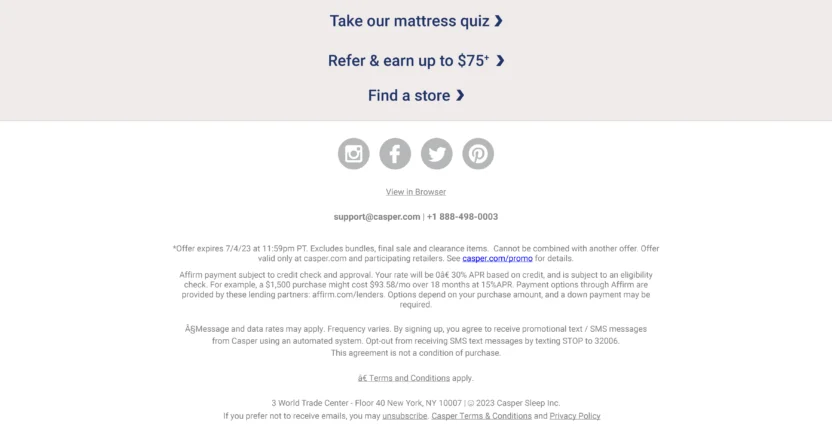
Source: https://reallygoodemails.com/emails/subscriber-exclusive-25-off-mattresses-our-best-july-4th-offer
Casper, the mattress company, makes it incredibly easy for subscribers to opt out. In the footer of every email, they include a prominent “Unsubscribe” link.
This simple, single-click process is a prime example of adhering to CAN-SPAM and GDPR requirements for easy unsubscribe. They also include their physical mailing address, as mandated by CAN-SPAM. Such transparency builds trust and reduces the likelihood of spam complaints, even from those who choose to leave.
2. Google Maps | Updating Email Preferences
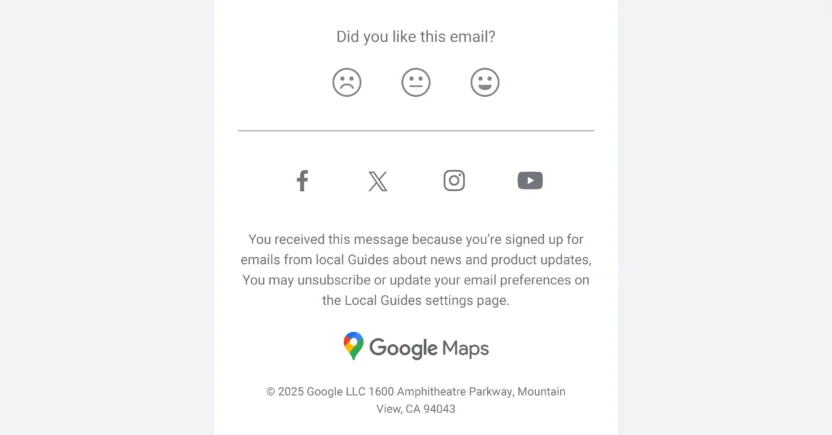
Source: https://reallygoodemails.com/emails/working-together-to-keep-maps-trustworthy
Google Maps goes beyond just a simple unsubscribe. While they provide an easy opt-out, they also offer an “Update your email preferences” link. Clicking that link lets recipients dictate exactly what kind of messages they want to receive (like traffic alerts, new feature updates, or local guides). This transparency doesn’t just comply with GDPR; it actively turns their email preferences into a self-serve buffet.
Why is this a genius move? Because Google Maps understands that compliance goes hand-in-hand with engagement. By letting subscribers tailor their inbox experience, they create lasting loyalty. Plus, fewer irrelevant emails equal fewer complaints.
3. National Geographic | Reason for Receiving Email

Ever opened an email and wondered, “Wait, why am I even getting this?” That’s what National Geographic proactively avoids in their campaigns.
With every email they send, they clearly explain why a recipient is on the list. It’s usually in the footer, written in plain language like, “You’re receiving this email because you elected to receive marketing communications from National Geographic under the terms of our Privacy Policy.”
This move satisfies GDPR and CAN-SPAM transparency requirements in style. It’s subtle but effective, baking trust into their email structure without making the message feel overly legalistic. Subscribers instantly understand how they got there (and how to get out, if needed).
6 Email Compliance Best Practices for Maximizing Impact
If you’re serious about maximizing the success of your campaigns while staying compliant (as you should be), here are six email compliance best practices to follow, now and forever.
1. Understand Email Compliance Regulations
The only thing worse than an email lawsuit is realizing you could’ve avoided one if you’d just Googled the rules. Email is regulated differently across regions, and understanding each territory’s laws is your first line of defense. From GDPR’s obsession with consent in Europe to the CAN-SPAM Act’s focus on clear sender identities in the U.S., these laws exist to protect customers from privacy breaches, spam, and deceptive practices.
Why does this matter? Because failing to understand the rules can be outrageously expensive. Google “GDPR fines,” and you’ll find headlines like Austrian Post paying €9.5 million in 2021 for not allowing customers to submit data subject rights requests via email. And these aren’t small players; they’ve got entire legal teams.
2. Set and Follow Compliance Procedures
You can’t enforce email compliance by winging it. What you need is a set of concrete procedures (a playbook, really) that dictate how your campaigns are created, sent, and monitored. This should include clear rules for collecting consent, managing subscriber data, and including legally required elements like opt-out links.
Take Meta as a cautionary tale. Back in 2019, Facebook was slapped with a $5 billion fine from the FTC for mishandling consumer privacy, largely because they failed to follow internal data handling procedures. While it wasn’t an email-specific case, the lesson applies all the same: don’t assume good intentions are enough.
The key here is consistency. Every campaign, whether it’s a one-off promo email or a long-term drip series, should undergo the same checks and balances. And yes, that means training your team (more on that next).
3. Train Employees
Your brand’s greatest compliance risk isn’t your email marketing automation software; it’s your recipients. The folks building those campaigns, importing email lists, and making split-second decisions on subject lines need to understand that email compliance isn’t optional.
Case in point: remember when Uber got raked over the coals for a massive data breach in 2016? Turns out, their employees didn’t use multifactor authentication to protect sensitive information on GitHub (oops). While this case wasn’t tied to email campaigns, it underscores the importance of training: even well-meaning mistakes can lead to PR disasters and skyrocketing fines.
Empower your team by regularly educating them on email laws, phishing risks, and consent practices. Host workshops, circulate guides, and make sure compliance training isn’t treated like a one-time thing. When your entire marketing staff knows what they can or can’t do, the odds of missteps drop dramatically.
4. Regularly Monitor Emails
Spam complaints, broken unsubscribe links, or accidental non-compliance can snowball into major issues if you’re not paying attention. Regularly reviewing email performance and keeping an eagle eye on compliance indicators is how savvy marketers stay ahead of potential disasters.
Start with the basics: monitor your bounce rates, track customer response to unsubscribe requests, and keep tabs on spam complaints. If you’re working with an ESP, confirm that their compliance tracking tools are active and integrated into your workflow. Periodic audits of your campaigns, both live and historical, can also help you catch errors before they slip through the cracks.
Think of it as spring cleaning for your email campaigns. Only, instead of Marie Kondo-ing your sock drawer, you’re scrubbing your lists, updating outdated consent data, and assessing whether your campaigns still align with today’s laws.
5. Stay Updated with Industry Trends
Staying ahead of industry trends and legal updates is what sets proactive marketers apart from reactive ones.
Keep tabs on updates to laws like GDPR or CAN-SPAM, monitor emerging data privacy laws (the California Privacy Rights Act of 2020 or CPRA, for example), and read enforcement case studies to learn from others’ mistakes. Even trends in technology, like increasing spam filter sophistication, can impact how compliant your campaigns appear to ESPs.
Regulatory watchdogs don’t tend to give a free pass just because a law is new. You’re still expected to follow it. Subscribing to newsletters from legal and marketing advisory platforms can help you stay informed.
6. Use a Compliant Email Marketing Platform
Sure, you could just rely on an ESP like Gmail or Yahoo. Or use an email compliance tool. Why not get the best of both worlds?
Cue: Get an email marketing platform with built-in compliance features. We’re talking automated consent management, advanced data encryption, and built-in SPF/DKIM/DMARC authentication. From tracking opt-in statuses to securing message delivery, you need a platform that’s designed to give you 100% peace of mind.
Email Compliance in a Nutshell: Conclusion
Email compliance is the last thing marketers dream about when brainstorming brilliant campaigns. Ironically, it’s the invisible foundation that allows those campaigns to succeed.
Now, the question is, could better tools have prevented the breaches we’ve mentioned above?
Absolutely.
So if you don’t want to join those brands with real-life horror stories of bungling email compliance, you need an email marketing platform designed with compliance at its core. An email platform like MoEngage, with robust features that can help you automate compliance and elevate your customer engagement strategies.
Ready to ensure your email campaigns are compliant and impactful? See MoEngage in action today.



